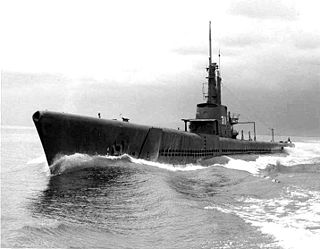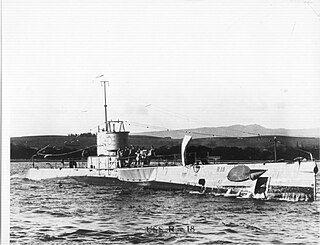
USS Bergall (SS-320), a Balao-class submarine in commission from 1944 to 1958, was the first ship of the United States Navy to be named for the bergall, a small fish of the New England coast. During World War II she made five war patrols between 8 September 1944 and 17 June 1945, operating in the South China Sea, Java Sea, and Lombok Strait and north of the Malay Barrier. During these patrols she sank two Japanese merchant ships totaling 14,710 gross register tons and one 740-displacement ton Imperial Japanese Navy frigate. She also damaged the Japanese heavy cruiser Myōkō, which was never repaired.

USS Archerfish (SS/AGSS-311) was a Balao-class submarine. She was the first ship of the United States Navy to be named for the archerfish. Archerfish is best known for sinking the Japanese aircraft carrier Shinano in November 1944, the largest warship ever sunk by a submarine. For this achievement, she received a Presidential Unit Citation after World War II.

USS Picuda (SS-382), a Balao-class submarine, was originally named Obispo, making her the only ship of the United States Navy to be named for the obispo, a spotted sting ray.

USS Bumper (SS-333), a Balao-class submarine, was a ship of the United States Navy named for the bumper, a small fish of the North and South Atlantic Ocean.

USS S-11 (SS-116) was a second-group S-class submarine of the United States Navy.

USS R-1 (SS-78) was the lead ship of the R-class coastal and harbor defense submarines of the United States Navy.

USS R-5 (SS-82) was an R-class coastal and harbor defense submarine of the United States Navy.

USS R-7 (SS-84) was an R-class coastal and harbor defense submarine of the United States Navy.

USS R-6 (SS-83) was an R-class coastal and harbor defense submarine of the United States Navy.

USS R-9 (SS-86) was an R-class coastal and harbor defense submarine of the United States Navy.

USS R-16 (SS-93) was an R-class coastal and harbor defense submarine of the United States Navy.

USS R-17 (SS-94) was an R-class coastal and harbor defense submarine of the United States Navy.

USS R-18 (SS-95) was an R-class coastal and harbor defense submarine of the United States Navy.

USS Raby (DE/DEC-698) was a Buckley-class destroyer escort for the United States Navy. She was named for Rear Admiral James Joseph Raby (1874–1934).

USS Thrush (AM-18) was a Lapwing-class minesweeper acquired by the United States Navy for the dangerous task of removing mines from minefields laid in the water to prevent ships from passing.

USS Riddle (DE-185) was a Cannon-class destroyer escort in service with the United States Navy from 1943 to 1946. In 1950, she was transferred to France where she served as Kabyle (F718) until being decommissioned and scrapped in 1959.

USS Fessenden (DE-142/DER-142) was an Edsall-class destroyer escort built for the U.S. Navy during World War II. She served in the Atlantic Ocean and the Pacific Ocean and provided destroyer escort protection against submarine and air attack for Navy vessels and convoys.

USS Blair (DE-147) was an Edsall-class destroyer escort in service with the United States Navy from 1943 to 1946 and from 1951 to 1960. She was scrapped in 1974. Blair was named in honor of Chief Machinist's Mate Eugene Blair, who was awarded the Silver Star posthumously for his brave actions when his ship was attacked and bombed by Japanese planes near Port Darwin, Australia, in mid-February 1942.

USS Keith (DE-241) was an Edsall-class destroyer escort in service with the United States Navy from 1943 to 1946. She was scrapped in 1974.

USS Loeser was a Buckley-class destroyer escort of the United States Navy, named in honor of Lieutenant Commander Arthur E. Loeser (1903–1942).




















